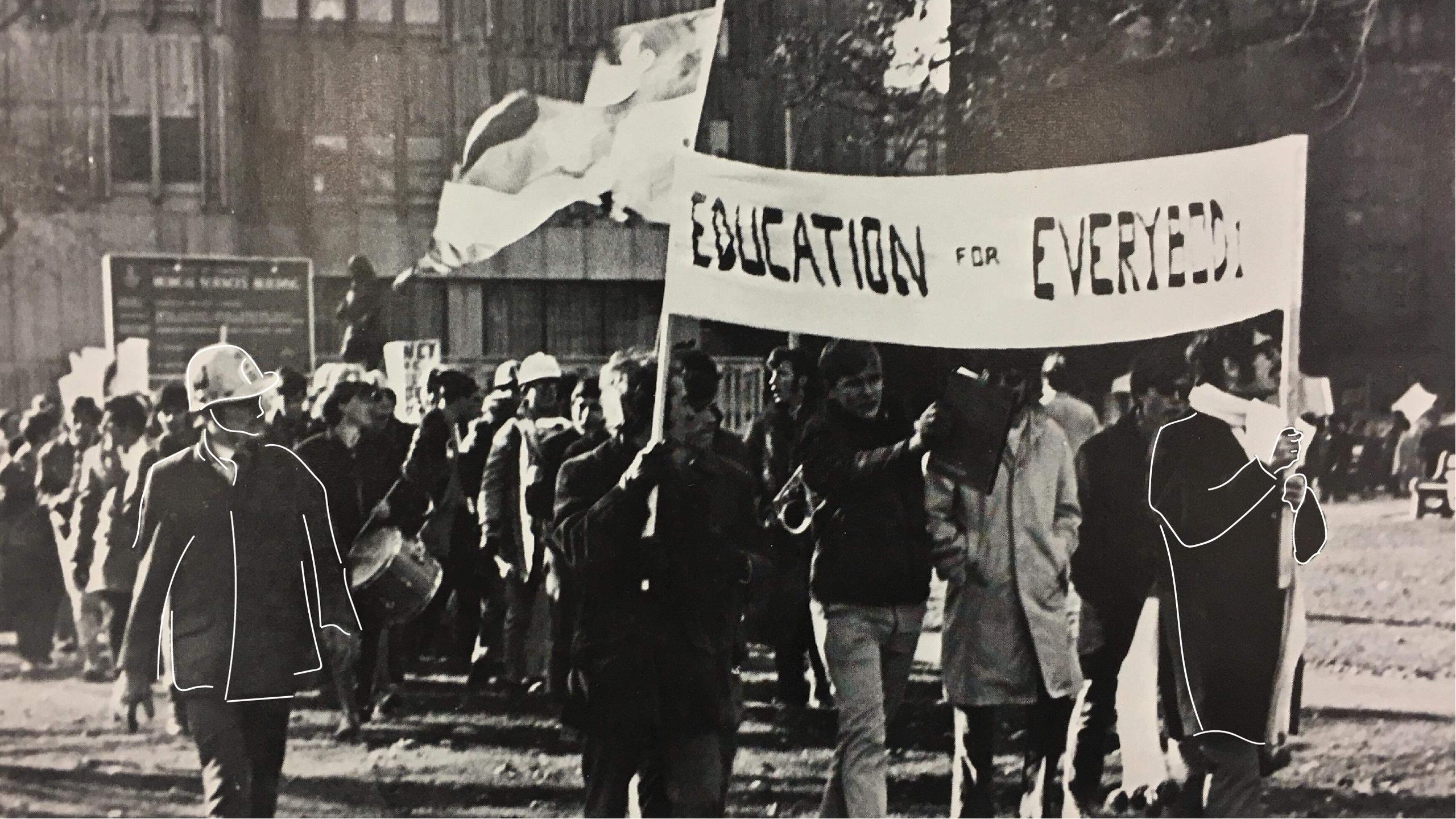By Neha Chollangi
Back in 1948, the Ryerson Institute of Technology, as it was called, had something the school doesn’t have today—yearbooks. It was the year of the polytechnic institution’s inauguration, with a little over 200 students enrolled in two-year programs, all of whom graduated in 1950 with a bound hardcover souvenir of their life at Ryerson.
The Ryersonia yearbooks were cheesy pools of graduation pictures, student groups and long paragraphs of farewells. They were perfectly bound collections of student life that read like run-of-the-mill yearbooks. All but one. The 1969 Ryersonia: A Visual Experience is a treasure and an avant-garde miracle. If I could pay the university hard cash to buy it, I would. It’s also the last one to ever be published.
The epitaph, at the very start of the book, explains it all.
“Ryersonia is dead. Nevermore to be resurrected,” it reads. “One of the reasons for the death is financial. To date, only 200 of last year’s 5,700 students have bought copies of Ryersonia 1969 at $5.00 per copy. The total revenue is only about $3,000. This yearbook cost nearly $30,000 to produce.”
The publication’s editor of the book, Roder C.H. Carter, wrote this obituary across two pages to explain that this will be the last Ryersonia yearbook to be produced after nearly two decades of publication. Besides the financial woes, the yearbook staff was low as most of them had “disappeared somewhere in the morass called Ryerson,” writes Carter. The year’s student affairs was in shambles. At the end, he says, “Remember, nobody should be blamed for this mess. Too many people lost interest too quickly in this dying tradition.” Before signing his name off, Carter makes a few suggestions for readers:
(1) Look for any pictures you like.
(2) Cut them out.
(3) Save your pictures and burn the rest. It wouldn’t mean anything to you anyways.
“It’s basically the tale of a yearbook editor who became disgruntled,” said Curtis Sassur, Ryerson’s archivist. The archives are a library of Ryerson’s memories, filled with odd relics like all the Ryersonias and other special collections. Sassur said there’s a lot of bitterness in the pages of the Ryersonia, along with a healthy dose of youthful rebellion.
The last Ryersonia is the epitome of everything ‘60s and angsty. Even for the ‘60s, it’s pretty out there. The book itself is chaotic, perhaps reflecting the state of the university or, at the very least, the yearbook staff. There’s no order and very little writing. There’s no structured layout of graduating students, either. Even the pictures have no captions, context or photographer information, and it’s hard to tell if most of them are even remotely related to Ryerson. I’m truly surprised that it got approval to get published in the first place. It’s like one of those art books you find in the giftshops of art galleries made by a drugged out, wacky artist with no filters.
Some pages of the book are randomly blank for no reason. Other pages read absurd inscriptions like: “This page is blank because the entire yearbook staff is having an orgasm. In other words, pure and simple, this is just another filler. “Besides it would be worse if we wasted our valuable space to write something favourable about the administration.”
But the photography is a peculiar mixture, too. Some are gorgeous artistic portraits, a close up of a couple laughing, or an underwater shot of a swimmer with bubbles around his face. There’s also fantastic street photography of protests about education and the Vietnam War. Some pages are just scans of negative print sheets and others of random animal faces. The order they’re arranged in is loose with only little cohesion. Sadly, most of these pictures cannot be republished because of privacy laws around the former students.
Come 1969, there would never be a yearbook again. The Ryersonia ended with a bang. A strange, confusing bang. There was an issue published in 1998, but as a special edition for the 50 year anniversary of Ryerson. It has the same vibe as a high school yearbook, similar to the clean and square style of all the nine books before 1969.
To see the history of Ryerson through these yearbooks is a rare but riveting lens. As the pages turn, you can see the school transition from a glorified high school into an institution much more aware of itself. But the student voice in the 1969 Ryersonia is what struck me the most, Ryerson students were unapologetic and defiant. It’s harder to conceptualize the spirit of the school when it isn’t archived. What would a modern Ryerson yearbook look like anyway? A collection of zones?
Outsiders often poke fun at Ryerson for not being a ‘serious’ or ‘real’ university with a rich past. Compared to the University of Toronto’s stone walls, draped with overgrown ivy and a history that trails back to 1827, Ryerson is a baby or more of an unruly teenager. But it does have a unique and quirky past, one that seems to have an uncanny resemblance to its “edgy” Ryerson students of today. Those old stories of student rebellion, endless creativity and the bitter Ryerson spirit are quietly contained in books on the fourth floor of the library building.But those stories continue on today, whether someone’s recording them or not.











ersin okandan
I am looking for the graduates’ list in 1969
Plese help
Thanks
e
Frank D.
I graduated from Ryerson in 1975, and while I was a student working at the campus closed circuit radio station, I found a stash of the infamous 1969 Ryersonia yearbooks mentioned in this article, clearly having been abandoned in a storage room. I took a copy and still have it….
Frank